I’m always interested to see if there are creative ways to learn things faster. Recently, I tried my hand at learning a skill a bit outside my previous experiences with ultralearning projects: drawing faces.
In this post, I’ll share why and how I did the project. I’ll show some unconventional methods I found worked well for speeding up the learning process. Although a lot of what I’m discussing will be specific to drawing portraits, the principles can apply to learn many skills. So even if you aren’t interested in art, I think there are important insights for learning any complex skill.
This post is a summary, but I like to document my projects as thoroughly as possible. For those interested in digging deeper, I’ve uploaded every sketch, drawing, materials used, courses taken and even a daily journal I kept to the project page.
This is going to be a long post with numerous images, technical notes and detailed descriptions. In case you just want the summary and implications for learning other skills, jump to the conclusion here. Otherwise, let’s dive in!
Motivation and Preparation for the Project
The motivation for this project came almost by accident. I had gotten interested in art again, something I had enjoyed in high school, but fell by the wayside as I had to start focusing on more “important” things. In that rekindling process, I discovered a great book—Drawing on the Right Side of the Brain.
This book teaches a generalized approach to drawing which focuses mostly on perceptual skills. Not how do you hold the pencil or do shading, but rather, how do you actually see what is in front of you in an accurate way.
I completed the course (it took about 20 hours), but when I got to the portrait drawing section it was still frustrating. Despite my best efforts, I couldn’t produce a drawing that really looked like the person I was going to draw.
Drawing faces was a miserable process full of acute frustration for me. Unlike landscapes or objects, where, with luck, I could get something I was happy with at the end, I couldn’t bring myself to even look at my attempted drawings of real people.
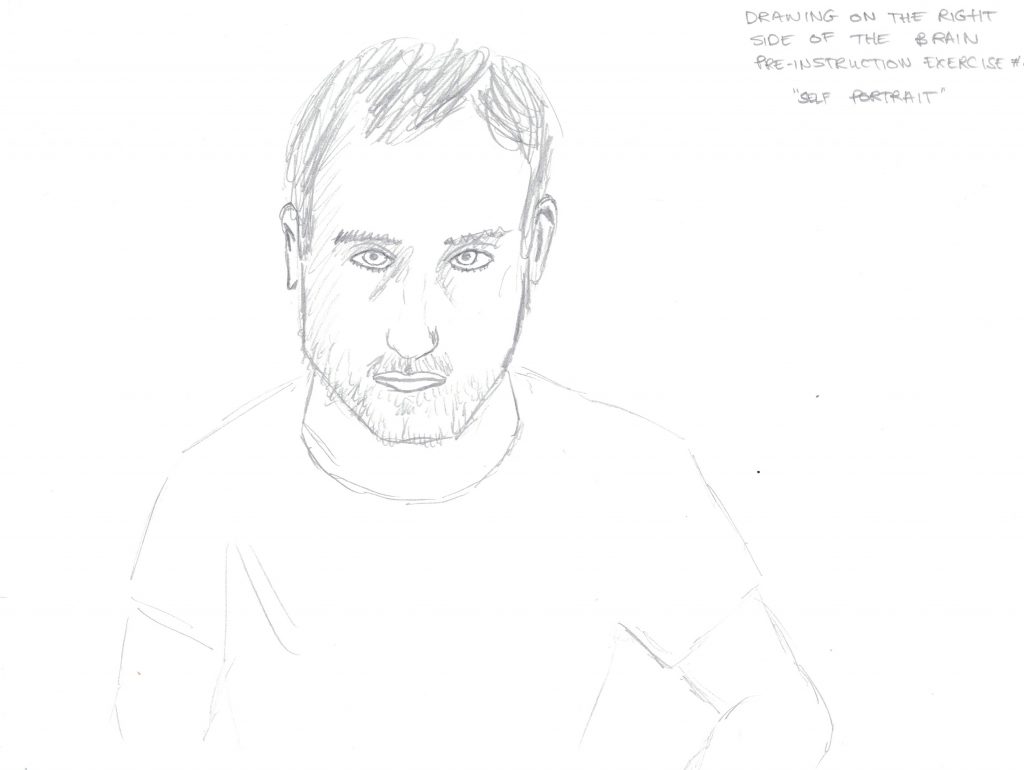
A frustrating self-portrait I attempted a few months before starting this learning project, just before starting Drawing on the Right Side of the Brain.
It was this mixture of frustration for drawing portraits and my admiration for people who could do it well, that inspired me to try tackling it in an ultralearning project. I felt that if I could learn to draw faces well, that would not only teach me important artistic skills, but give me confidence that I could then apply to future artistic projects.
My commitment to the project was simple: I would work on improving my ability to draw portraits with graphite over thirty days. I also added an additional constraint: twenty-five hours per week maximum. This meant five hours per day, Monday to Friday. That gave me enough time to make serious progress, but not so much time that I couldn’t continue my normal work responsibilities.
Note: My choice of twenty-five hours per week was entirely arbitrary. If you wanted to work on the project full-time, you could probably put in more. If you had a full-time job, you may only be able to commit fewer hours. I think, however, if you simply increased or decreased the total time of the project, you could get at a similar result. (If you could only put in 12.5 hours per week, let’s say, then budgeting 2 months would probably be equivalent to my project.)
Beginning the Project: Skill Deconstruction and Rapid Feedback
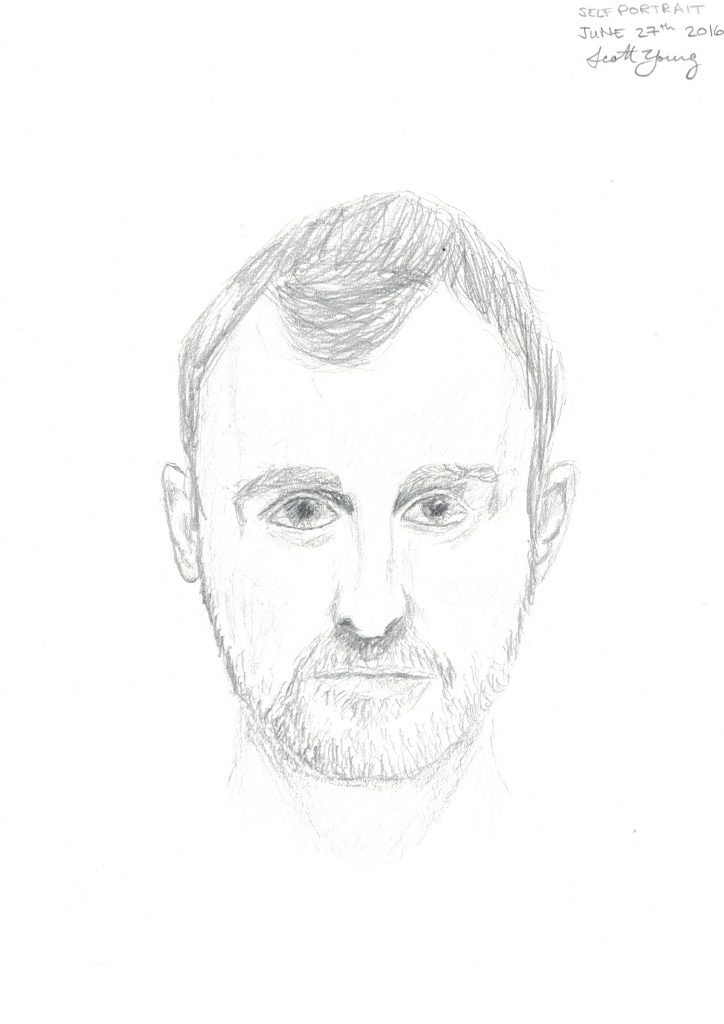
My self-portrait on Day 1 of the project.
The hardest part of drawing faces is that our brains are wonderful facial-recognition machines. If an eye is even a few millimeters off of the position its supposed to occupy, we get a strange sense that something is wrong. An expression can go from content to bored with only a few line widths of difference.
This means that drawing faces, unlike say chairs or trees, requires an incredible level of accuracy in order to be compelling.
Note on technique: One way around this is to exploit techniques that make accuracy problems go away—trace the image, use a projector or put a grid on the images and the drawing to make sure everything matches. Although these are valid techniques, they shortcut rather than train the real ability I wanted (to be able to draw faces using only my eyes and a pencil), so I made a point of not using them during the project. No disrespect is meant if you prefer these methods (some of the great artists also used them).
My first step was to try to isolate this component of the skill: correctly placing and sizing facial features, and practice it quickly and repeatedly.
I decided to do this by drawing tons of faces. Every day I would do one “finished” portrait, spending about an hour or two. This would allow me to see progress clearly. On top of that I would do drills of trying to do line drawings of faces quickly. This latter goal would give me a tighter feedback loop so I could get better at the component skill of sizing and placing facial features without needing to worry about things like shading or hair.
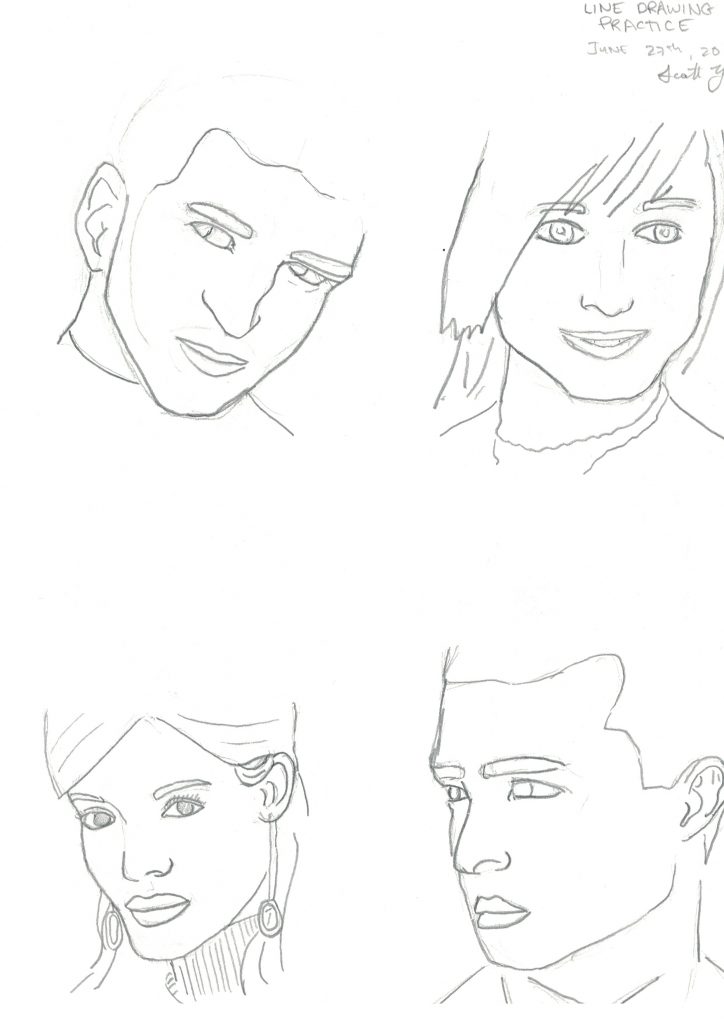
An example of my early line drawings. Each took ~10-15 minutes.
Just drawing lots of faces wasn’t enough, though. I wanted to know *what* mistakes I was making, not merely that I was making them. To get good feedback, therefore, I used a simple trick: after finishing a page of line drawings, I’d photograph it, and then overlay a semi-transparent version of the reference photo, resize and align it with my picture. From this, I could easily see whether I had made the forehead too big, eyes too far apart or head too wide, for example.
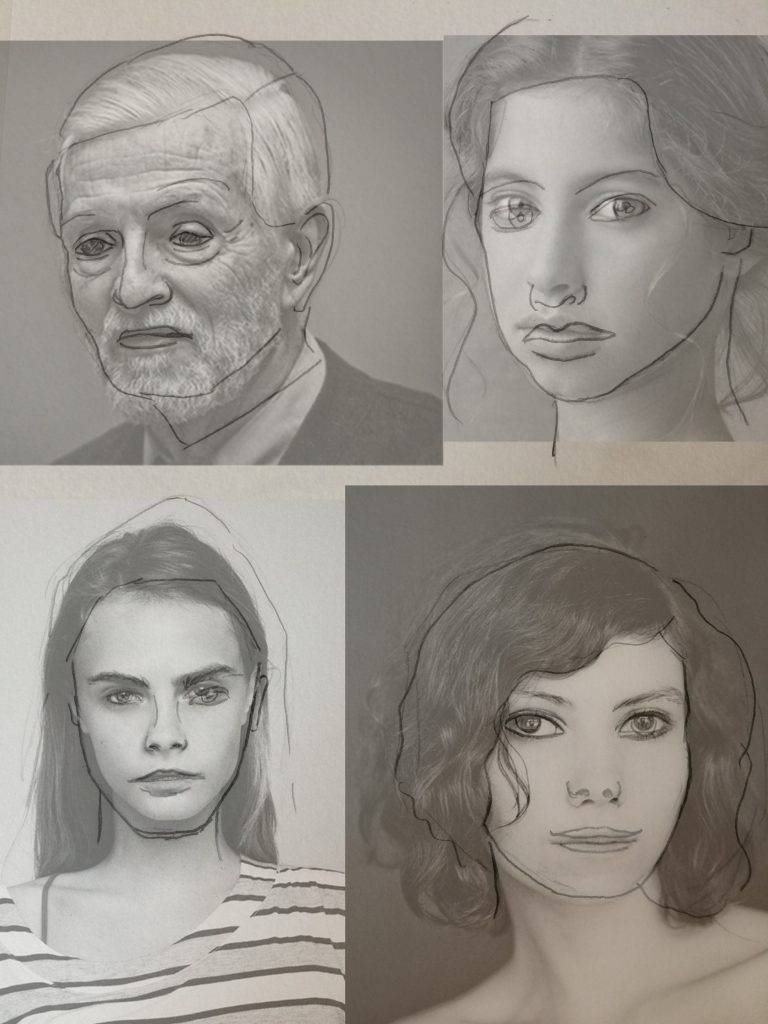
Overlaying a photo of my drawings to see my mistakes clearly.
I followed this approach for several days: one finished portrait, followed by a dozen or so line drawings. However, I was still spending a lot of time on each line drawing (10-15 minutes), and I felt the feedback wasn’t as fast as I would like.
To fix this, I decided to be more aggressive, switching to smaller, ultra-fast sketches (20 seconds each). These drawings no longer resembled the reference photo much at all. However, they did enable me to get broad features (head width, eye level, etc.) once I compared them with the overlay.
After completing over a hundred of these smaller sketches, I switched back to a middle approach—doing the original line drawings, but only spending 4-5 minutes per drawing. These were larger and enabled greater accuracy assessments from the reference photo overlays (for instance, I could compare eye size, something which was too fine-grained in the quickest drawings).
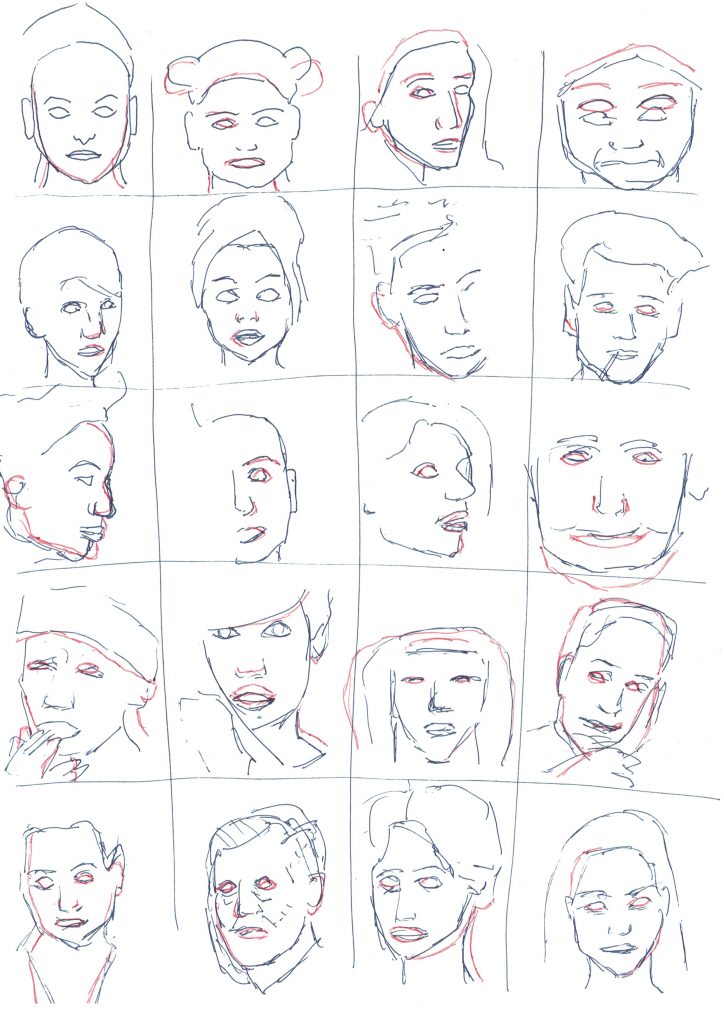
These smaller drawings were done ~20 seconds each. I used red pen, after comparing with the overlaid reference photo, to mark where the features were supposed to be to make my feedback more concrete.
Middle-Project: Hitting a Wall and Overcoming it Via New Methods
Around the middle of the project, my technique for doing finished portraits, had become fairly well established. I would draw the head, attempt to place the features roughly, look at it, make a guess where things needed to be adjusted, erase those features, redraw them and repeat.
Unfortunately, that last part—repeat—tended to happen quite often. Some drawings required redrawing the eye position up to a dozen times. And after all that was done, I was often still unsatisfied by the likeness of my drawings.
I had gotten better at drawing faces, but my level of frustration while drawing was mostly the same. I could get things to look a bit like the person I was drawing, but that only made it all the more frustrating when things didn’t look right.
Unfortunately, my line drawing repetition technique was running out of steam. I wasn’t getting much better or faster, despite having now done hundreds of repetitions. This is common with skill improvements—you’ll see quick beginner gains, then diminishing returns as you keep practicing.
I knew, if I wanted to keep getting better before the project was over, I’d need a shock. Something to push me to a new level of method and accuracy.
Searching around extensively online, most of the tutorials I found were lousy. They advocated methods I’d already forsworn such as the grid or tracing method. Or they would focus on beautiful timelapses that heavily emphasized shading (a relatively easy part) instead of accurate feature placement (what I found most difficult).
Eventually, however, I stumbled across this course by Vitruvian Studios. It turned out to be exactly what I needed and broke me out of my barriers with drawing by introducing me to new methods which challenged my existing approach to drawing and gave me new tools to deal with the challenges of drawing a portrait.
In particular, it taught:
- To landmark important points on the face using triangulation. This is a method where you observe and copy angles as you perceive them. This allows you to get the head width, shape and feature placement fairly accurate before you start drawing in the exact curves and lines. The downside of this method is that it is time-consuming, so it isn’t possible to use for quick sketches.
- To draw the face from the outside-in. Combined with the triangulation method, this allows you to build up more and more of the face before committing to finer details, allowing the portrait to have increasing accuracy as it progresses.
- Using toned paper along with chalk (aka white “charcoal”). This makes drawing highlights easier, since you don’t need to shade down the entire paper to make a single point the brightest on the page.
- Establishing tonal ranges early in a high-contrast spot. Starting shading on a spot which has nearly the full range of values you want for the drawing allows you to establish a tonal range early, so you don’t have as much work to do re-shading whole areas when you realize something isn’t dark/bright enough.
- Understanding the geometry of the face. Instead of just thinking of matching tone, try thinking about the face as if it were a 3D object.
This produced an immediate improvement in my finished portraits and allowed me to get onto a new improvement curve. Now, I was back at the beginner phase for these new methods, where progress can still be made easily simply through repeated practice.
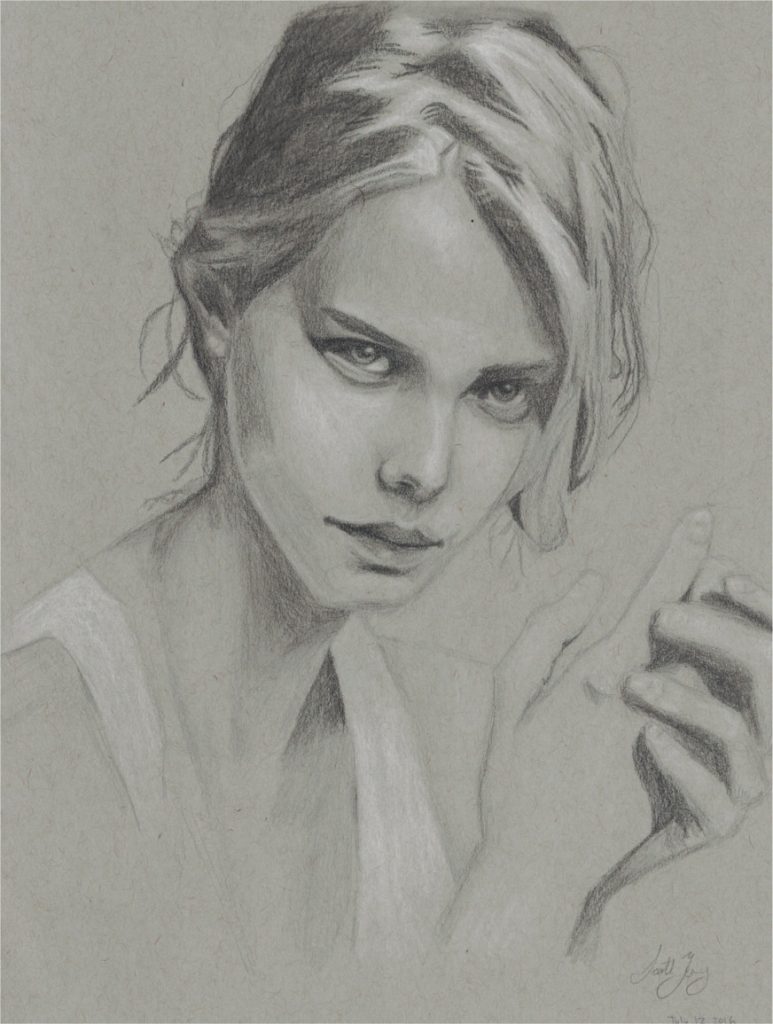
My first portrait after taking the Vitruvian Portrait Course.
Project End: Revisiting my Self-Portrait
The last part of the project had me continue to focus on the Vitruvian methods for doing finished portraits. I stopped doing the fast line drawings and focused on trying to get comfortable with the process as taught.
In the beginning, this method seemed so different from my prior approach, that it almost felt like my line drawing practice was a waste. What was the point of guessing where features lay if there was a method for placing them exactly?
However, as I reached the end of the project, I found there was a nice fusion between the two approaches. The triangulation technique and methodical approach to drawing portraits as taught in that course gave me a good first step in positioning things. But, ultimately, the ability to see a likeness and know where things needed to be adjusted was invaluable as a complementary skill. Using both of them meant I could get more accurate results than either alone.
Near the end, I decided to revisit my self-portrait. This was my third attempt, after the frankly disastrous first attempt prior to starting Drawing on the Right Side of the Brain which had spurred me to start the project, and my second attempt, which I did on the very first day of the project.
Knowing more, I made sure to get a good photo with decent lighting and resolution. I opted for the 3/4 view this time, since it tends to be more interesting and showcases the skills I obtained more easily since the features are no longer symmetrical in the 2D plane.
I spent about ten hours on this final portrait (in contrast with roughly one hour on the previous two portraits).
In addition to the triangulation and gestalt techniques for blocking in and adjusting the face, I also made relative measurements. I would do this by locking my arm outstretched, closing one eye and perceiving the distance between two arbitrary points (say the corner of the left eye and the bottom of the ear) using the pencil. I would then try to “match” this distance with another set of two points which, in theory, shouldn’t be related. In particular, I’d try matching mostly horizontal distances with mostly vertical distances, since these would only be coincidentally the same and therefore it would be unlikely that the two would both be incorrect in exactly the same ways. If those two distances also matched in my own drawing as well, I could be reasonably confident they were drawn correctly.
The end result was the first self-portrait I felt actually looked like me!
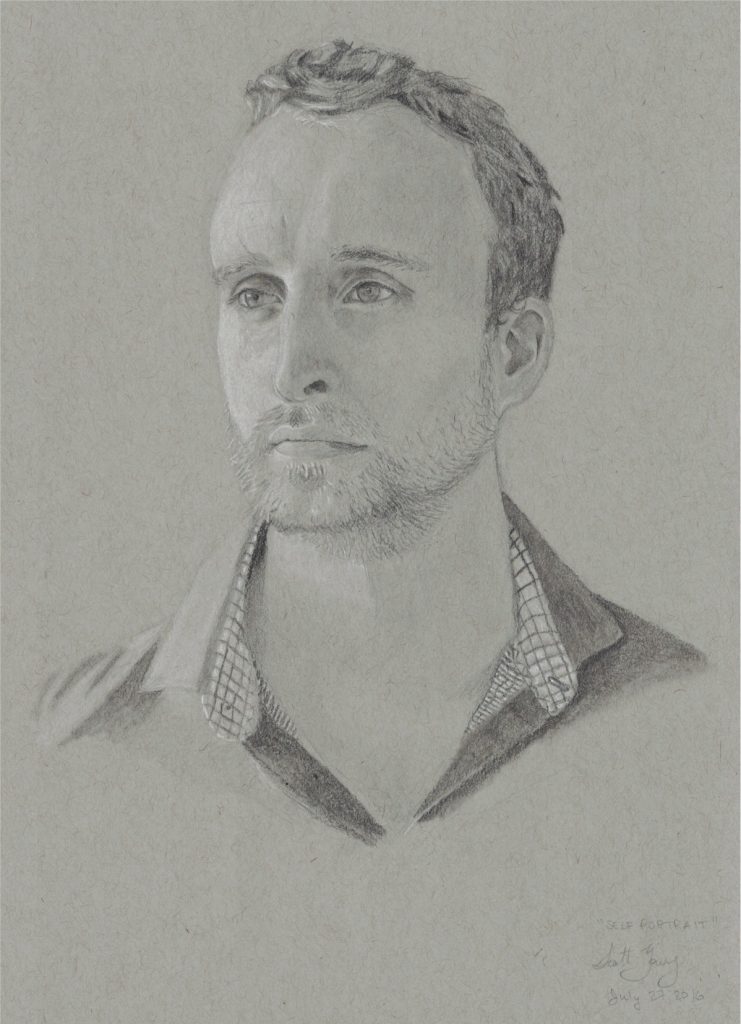
My self-portrait after 30 days of practice
Certainly there are further improvements I can make that I couldn’t accomplish in one month. There are still professional artists whose work puts mine to shame, and a lot of areas I can still get better at. However, given my starting point and goal to be able to draw reasonably realistic portraits, I believe this challenge was a success.
For those interested in seeing all the images, here’s a flipbook which contains every sketch and finished drawing (including some false starts), in chronological order:
Concluding Thoughts: How This Applies to Learning Any Complex Skill
I believe there were a number of factors that allowed me to make decent progress on this skill in a constrained period of time. I also believe that these factors can be replicated by anyone, and while they do require hard work and focus, they don’t depend crucially on having high amounts of natural talent to see improvement.
Here are the main lessons I took from this project I’ll continue to apply elsewhere:
- Designing the project and constraints is critical. This project worked because it was well designed. I focused only on portraits. And even then, only on graphite, black-and-white drawings. If I had decided to just get better at “painting” or “art” improvement would have been frustrating. Choosing the right level of specificity makes progress tangible, which is a big part of the motivation to keep working.
- Improvement comes mainly through practice cycles. A practice cycle consists of applying a method and then getting feedback. The more of these you can do, the better you’ll get. The more accurate the feedback is, the more powerful each cycle. The more effortful and focused the practice attempt, the more powerful the cycle. Using reference-photo overlays, accelerated drawings and meticulously practicing an established method all enabled quicker progress than just doing a bunch of doodling and hoping to get better.
- Theory allows you to break through old barriers. Eventually practice cycles will make less and less progress as you “master” a particular approach. Getting better, then, requires a new method or an adjustment to your existing routine. This can come from coaching, experimentation, or in my case, from discovering a different method and learning it.
- Different methods can synthesize to form mastery. Learning both a gestalt-based and triangulation-based method solved different challenges in my drawing and allowed me to progress more than one on its own. If I wanted to go even further, I might try anatomically-based method or those based on drawing caricatures. Mastery is often just having a large repertoire of well-practiced procedural techniques.
- Focus is hard, but also necessary. Deliberate practice is hard work. I often found even putting in five hours of concentration per day to be difficult. Training the ability to focus without switching to distractions is one of the biggest learning assets you can hope to develop, and it can continue to pay off in future projects.
- Don’t be afraid to learn hard things! I started this project unsure how it would proceed. Indeed, I was so unsure I didn’t want to mention it until I finished (in case I failed miserably). It’s easy to look retrospectively and assume that progress was inevitable, but learning new things always involves an element of risk and uncertainty. However, by challenging your conceptions of what you can learn and going all-in, you can often do much better than you believe yourself capable of.
What’s next for me? The ultralearning project is over, but, as always, I like to continue improving more casually with the skills I’ve gained. I find, once the frustration barrier is surmounted, using a skill is pleasurable, so low-effort maintenance and growth isn’t too difficult.
I’m currently working on a new portrait pencil drawing for fun. I’m also hoping to move to doing oil portrait paintings, something I had wanted to do for awhile and for which doing drawings was an intermediate project. I’m not sure whether I’ll pursue this as an ultralearning project or more casually, but when I do make progress, I’ll try to add it as an appendix to the original project page.
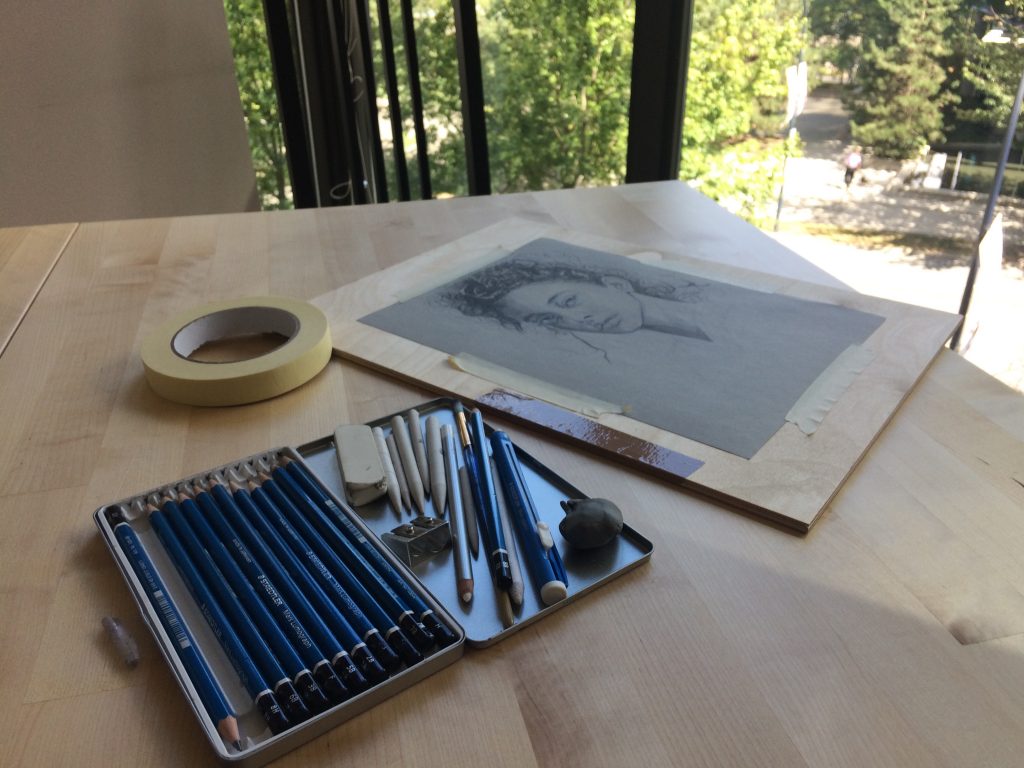
Interested in drawing? Curious to see my progress day-to-day? Would you like to do a similar challenge yourself? I’ve uploaded every sketch, finished drawing, journal entry and lists of all the materials and resources I used to the project page.


 I'm a Wall Street Journal bestselling author, podcast host, computer programmer and an avid reader. Since 2006, I've published weekly essays on this website to help people like you learn and think better. My work has been featured in The New York Times, BBC, TEDx, Pocket, Business Insider and more. I don't promise I have all the answers, just a place to start.
I'm a Wall Street Journal bestselling author, podcast host, computer programmer and an avid reader. Since 2006, I've published weekly essays on this website to help people like you learn and think better. My work has been featured in The New York Times, BBC, TEDx, Pocket, Business Insider and more. I don't promise I have all the answers, just a place to start.